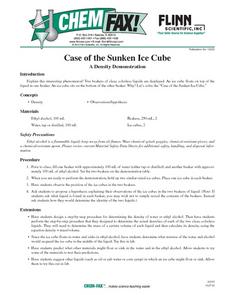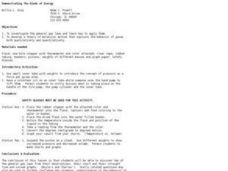Curated OER
The Same but Different Part II
Third graders experiment with beakers of water and balloons to measure the volume of the gas in the balloon. They determine ways to change the volume of air in the balloon which changes its size but not its physical state. By heating the...
Curated OER
Estimating the Live Mass of Dinosaurs
Students calculate the volume of scale model dinosaurs using a water displacement method. They use formulas to calculate the live mass each of the species of dinosaur. Then they complete and discuss a series of questions.
Cornell University
Buoyancy
Swimmers know to float by turning their bodies horizontally rather than vertically, but why does that make a difference? In an interesting lesson, scholars explore buoyancy and the properties of air and water. They test cups to see which...
Curated OER
Physical Changes and States of Matter
Fourth graders identify a physical change as one that results in a change in size, shape, or state of matter. After an initial teacher-led discussion and demonstration, groups of students get together to perform an experiment which...
Curated OER
Galileo's Thermometer: Measuring the Density of Various Unknown Liquids
Sprouting scientists explore the concept of density by making mass and volume measurements for five different liquids. From these measurements, they calculate densities. They apply their learning to explain Galileo's thermometer works...
Cornell University
Density
Certain things just do not mix, including liquids of varying densities. Learners collect data to determine the densities of several liquids. They then use the density information to predict the type of liquid.
Curated OER
Determination of the percentage of Acetic Acid in Vinegar
Students determine the concentration of acetic acid when the concentration of the base with which is titrated is known. They investigate how to weigh a sample using the balance, measure volumes using graduated cylinder, explore the...
Curated OER
Why Cheerios Don't Sink
Students investigate Archimedes' Principle and show how it relates to density. In this Archimedes' Principle lesson plan, students experiment with a beaker of water, a Styrofoam "boat" and a weight. They predict what will happen when the...
Curated OER
Chemistry Is a Gas
Young scholars investigate the gas laws and how they apply to changes in gases. In this gas laws lesson, students use Boyle's Law and Charles' law to show the relationships between pressure and volume and volume and temperature of gases.
Curated OER
How Big is a Molecule?
Students calculate the size of a molecule. For this molecules and their sizes lesson plan, students find the size of an oleic acid molecule by using a measured amount of drops of oleic acid to find the volume of the sample, the thickness...
Curated OER
Density-Qualitative and Quantitative
Students investigate density using film canisters filled with different density materials and larger objects of varying density. In this density lesson plan, students discuss the concept of density and rank film containers from dense to...
Curated OER
How Sweet It is! A Colorful Sugar Solution Density Column
Students examine the affect of density. Using a graduated cylinder and equally prepared volumes of sugar-water solutions and food color, students observe a sugar rainbow. They discover that the greater the amount of sugar in the...
Curated OER
Introduction to Density
Seventh graders define density in their own words. In this physics lesson, 7th graders solve density problems using its mathematical formula. They explain why some objects flow and some sink.
Curated OER
Space Exploration
Fourth graders observe an empty 14 oz. clear plastic cup and measure how much water the cup can hold when it is completely full. They work in groups to fill the plastic cup, but half of the groups receive a smaller vial and the other...
Curated OER
Physical Changes and States of Matter
Fourth graders study evaporation and condensation as parts of the water cycle. First they determine the similarities and differences between a cup of water and an ice cube before measuring the volume of ice before melting it, and...
Curated OER
Visual Models of Solutions and Concentrations
Students model solutions with beakers of colored glass or plastic spheres. For this solutions lesson, students use beakers of colored spheres to represent pure substances. They mix the spheres to demosntrate solutions. They discuss...
Curated OER
Chemistry: The Case of the Sunken Ice Cube
Students examine a density demonstration involving ice cubes and beakers of water and alcohol. After observing how one ice cube floats in water and sinks in alcohol, they determine which mixture of the two would suspend the ice cube in...
Curated OER
Demonstrating the Kinds of Energy
Learners experiment with inner tubes, weights, flasks, and pistons to demonstrate the gas laws. In this molecular motion lesson, students demonstrate pressure as a force per area. They conduct an experiment to show the relationship...
Curated OER
Pumpkin Properties are a Smash!
Learners receive a miniature pumpkin and proceed through several stations to measure a variety of physical properties. The data is entered into a data sheet and the mass and volume measurements are used to calculate density. They also...
Curated OER
Acidity of Soda Pop
Students conduct an experiment to determine the acidity of three different brands of soda by adding a known volume of base until a pink color appears in the reaction vessel. They test fresh and flat soda, observe any differences, and...
Curated OER
Where in the World is Carbon Dixoide?
Students conduct experiments designed to detect the presence of CO2 by using a BTB that changes color (blue to yellow) in the presence of CO2. First, students experiment with the CO2 from combining vinegar and baking soda. In part two,...
Curated OER
Density of a Gas
Eighth graders investigate the mass, volume, and density of a gas by producing it in a chemical reaction. The entire Density of a Gas Lab and L section of the K W L chart be formatively assessed.
Curated OER
Float or Sink?
Students examine why some objects float while others do not. They place various objects in water to observe their floating capability. Students record the object, its weight, and if the object floated. They construct a graph plotting...
Curated OER
The Same But Different
Third graders observe a frozen container filled with ice and discuss what happens when the ice sits out in the room. They practice measuring the mass and volume of the ice, watch as the frozen container is placed in a warm water bath to...

























